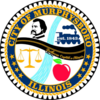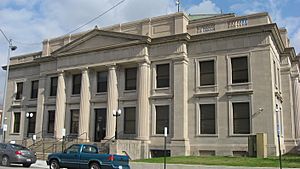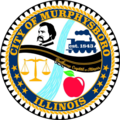Murphysboro, Illinois facts for kids
Quick facts for kids
Murphysboro, Illinois
|
|||
|---|---|---|---|
| City of Murphysboro | |||
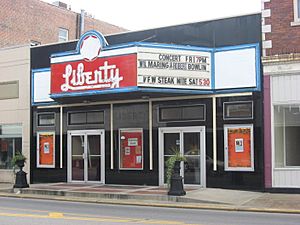
Liberty Theater, 2013
|
|||
|
|||
| Motto(s):
"Ripe with possibilities"
|
|||
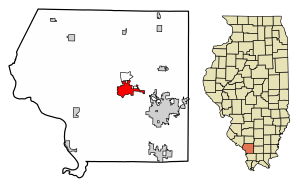
Location of Murphysboro in Jackson County, Illinois
|
|||

Location of Illinois in the United States
|
|||
| Country | United States | ||
| State | Illinois | ||
| County | Jackson | ||
| Townships | Murphysboro, Somerset | ||
| Founded | 1843 | ||
| Area | |||
| • Total | 5.33 sq mi (13.81 km2) | ||
| • Land | 5.25 sq mi (13.59 km2) | ||
| • Water | 0.09 sq mi (0.22 km2) | ||
| Elevation | 410 ft (120 m) | ||
| Population
(2020)
|
|||
| • Total | 7,093 | ||
| • Density | 1,351.56/sq mi (521.86/km2) | ||
| Time zone | UTC-6 (CST) | ||
| • Summer (DST) | UTC-5 (CDT) | ||
| ZIP Code(s) |
62966
|
||
| Area code(s) | 618 | ||
| FIPS code | 17-51453 | ||
| GNIS feature ID | 2395141 | ||
| Wikimedia Commons | Murphysboro, Illinois | ||
Murphysboro is a city in Jackson County, Illinois, United States. It is the main city of the county. In 2020, about 7,093 people lived there. The city is part of the Metro Lakeland area. Murphysboro is led by its mayor, Will Stephens, and 10 city aldermen.
Contents
Geography and Climate
Murphysboro covers about 5.33 square miles (13.81 km²). Most of this area is land. The city is located about 5 miles (8 km) southeast of Kinkaid Lake. Even though the Mississippi River is only 10 miles (16 km) east, the closest place to reach it is about a 30-minute drive away.
Murphysboro has a humid subtropical climate. This means it has warm, humid summers and mild winters. Because of this climate, some types of palm trees that can handle cold weather can grow here all year. You might spot a few around the city!
History of Murphysboro
Founding the City
Murphysboro was started in September 1843. It became the second main city, or county seat, for Jackson County. The city was created after a big fire destroyed the courthouse in the first county seat, Brownsville. This fire made people decide to move the county seat to a more central spot.
The new town was named Murphysboro after William C. Murphy. His name was chosen from a hat! Three people picked the new location, which was a 20-acre (8.1 ha) piece of land. This land was given by Dr. John Logan and Elizabeth Logan.
John A. Logan's Legacy
The son of the land donors, Major General John A. Logan, became a hero in the American Civil War. He was a volunteer general. General Logan also had a great career in politics. He served as a US senator for Illinois from 1871 to 1877 and again from 1880 to 1886. He even ran for vice president in 1884.
One of Logan's most important actions was creating Memorial Day. This holiday is now celebrated across the nation.
Early Economy
For many years, Murphysboro's economy relied on coal. The city was also important for its industries and transportation.
Major Weather Events
Murphysboro has faced some very powerful storms.
- On March 18, 1925, a huge tornado, known as the Tri-State tornado, hit Murphysboro. It killed 234 people. This is the highest number of deaths in one community from a tornado in US history. The tornado almost completely destroyed the city.
- Another strong tornado hit the area on December 18, 1957. It caused a lot of damage to the southeast part of town.
- In May 2009, a severe storm called a derecho affected the city. It destroyed homes, knocked down power lines, and left the town without electricity for a week. Sadly, one person died from a falling tree branch.
Solar Eclipse Event
In 2017, Murphysboro was a special place for the solar eclipse of August 21, 2017. The longest time the sun was completely covered (2 minutes, 41.7 seconds) happened near Murphysboro. This spot was about 5 miles (8 km) southeast, in Giant City State Park.
Community and Culture
Revitalization Efforts
Recently, groups focused on business and tourism have worked to bring new life to Murphysboro. They want to make it a center for history and culture.
Organizations like the General John A. Logan Museum and the Murphysboro Tourism Bureau are working together. They are helping to restore important buildings. These include:
- The band shell in Riverside Park, which is an example of a large project from the Works Progress Administration.
- The Robert W. Hamilton House, a well-preserved example of 19th-century Carpenter Gothic architecture.
- The Liberty Theater, which used to be a movie theater. Now, it hosts regional film festivals, concerts, and "nostalgia nights."
The Logan Museum Neighborhood is also part of this effort. Some homes in this area are being turned into exhibit and gallery spaces.
- The Bullar House holds the museum's main offices and exhibits.
- The Sheyley House is where the Murphysboro Tourism Commission is located. It also has an exhibit about the town's history.
- The Hughes House is a gallery space for local artists.
- The Horsfield Printshop makes replica clothing for local schools and the General John A. Logan Museum.
Festivals and Events
Murphysboro is known for its fun festivals:
- The Apple Festival happens every year on the second weekend after Labor Day.
- The Big Muddy Brewfest takes place every October. It brings together over 100 breweries and attracts more than 2,000 visitors.
- The Oak Street Art Fair is held in the Logan historic arts neighborhood each April.
- The Big Muddy Monster Festival started in June 2023. It has attractions all around the city.
Transportation
The Jackson County Mass Transit District provides bus service. These buses connect Murphysboro with Carbondale.
Notable People
Many interesting people have connections to Murphysboro:
- Michael J. Bost (born 1960), a member of the U.S. House of Representatives.
- Gary M. Geiger (1937-1996), a professional baseball player.
- Theo Germaine (born 1992), an actor who lived in Murphysboro as a child.
- John A. Logan (1826-1886), a famous politician and soldier from the Civil War. He was a U.S. senator and helped create Memorial Day.
- Don Ohl (born 1936), a professional basketball player.
- Flynn Robinson (1941-2013), an NBA basketball player who won a championship with the Los Angeles Lakers in 1972.
Images for kids
See also
 In Spanish: Murphysboro (Illinois) para niños
In Spanish: Murphysboro (Illinois) para niños



